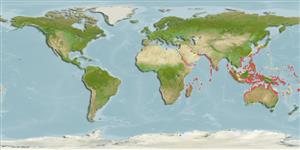Common names from other countries
>
Gobiiformes (Gobies) >
Gobiidae (Gobies) > Gobiinae
Etymology: Ctenogobiops: Greek, kteis, ktenos = comb + Latin, gobius = gudgeon + Greek, ops = appearance (Ref. 45335).
Environment: milieu / climate zone / depth range / distribution range
экология
морской ассоциированный с рифами; пределы глубины 1 - 15 m (Ref. 90102). Tropical
Indo-Pacific: widespread, from the Red Sea to the western Pacific, with records from the Great Barrier Reef and the Ryukyu Islands.
Size / Вес / Возраст
Maturity: Lm ? range ? - ? cm
Max length : 5.5 cm SL самец/пол неопределен; (Ref. 90180)
Краткое описание
определительные ключи | морфология | морфометрия
колючие лучи спинного плавника (общее число) : 7; членистые (мягкие) лучи спинного плавника (общее число) : 11 - 12; колючие лучи анального плавника: 1; членистые (мягкие) лучи анального плавника: 11. This species is distinguished by the following characters: D VI + I,11-12; A I,11; pectoral rays 19; longitudinal scale series 55-60; body depth 4.8-5.2 in SL; head length (HL) 3.1-3.3 in SL; dorsal profile of snout forming an angle of about 40° to horizontal axis of head and body; wide gill opening, reaching forward nearly to a vertical at posterior edge of eye; 2nd dorsal spine equal to or slightly longer than first spine and longer than the third spine, and about equal to the body depth (0.9-1.1); rounded caudal fin, 1.1-1.3 in HL; body with 4 longitudinal rows of dark brown spots, the 1st and 3rd as thick dashes, the spots of second row much smaller, except large first one over upper end of gill opening; 4th row ventrally on body with 2 or 3 spots on abdomen approaching pupil size, remaining spots only dark flecks; postorbital head with 3 oblique rows of dark dashes at an angle less than 45°, the 1st a single long dash behind eye, the next 2 across cheek, ending on upper half of opercle; 4 oblique rows of dark brown dashes and dots from eye across lips; median, dark brown, V-shaped mark dorsally on snout absent; in life, no small yellow flecks ventrally on body; larger dark spots on ventral half of body often encircled with blue dots; pectoral fins with a small white dash at upper base, a long white streak from base, narrowing into middle of fin (Ref. 90180).
Life cycle and mating behavior
Maturities | размножение | Spawnings | Egg(s) | Fecundities | личинки
Kovačić, M., S.V. Bogorodsky and J.E. Randall, 2011. Redescription of the Red Sea gobiid fish Ctenogobiops maculosus (Fourmanoir) and validation of C. crocineus Smith. Zootaxa 3054:60-68. (Ref. 90180)
Статус Красного Списка МСОП (Ref. 130435)
CITES (Ref. 128078)
Not Evaluated
Угроза для людей
Harmless
Использование человеком
дополнительная информация
инструменты
Специальные отчеты
Скачать в формате XML
ресурсы в Интернет
Estimates based on models
Preferred temperature (Ref.
115969): 24.7 - 29.3, mean 28.4 (based on 2743 cells).
Phylogenetic diversity index (Ref.
82804): PD
50 = 0.5020 [Uniqueness, from 0.5 = low to 2.0 = high].
Bayesian length-weight: a=0.00708 (0.00333 - 0.01504), b=3.09 (2.92 - 3.26), in cm Total Length, based on LWR estimates for this (Sub)family-body shape (Ref.
93245).
Trophic level (Ref.
69278): 3.5 ±0.45 se; based on food items.
устойчивость к внешним воздействиям (Ref.
120179): высокий, минимальное время удвоения популяции до 15 месяцев (Preliminary K or Fecundity.).
Fishing Vulnerability (Ref.
59153): Low vulnerability (10 of 100).
